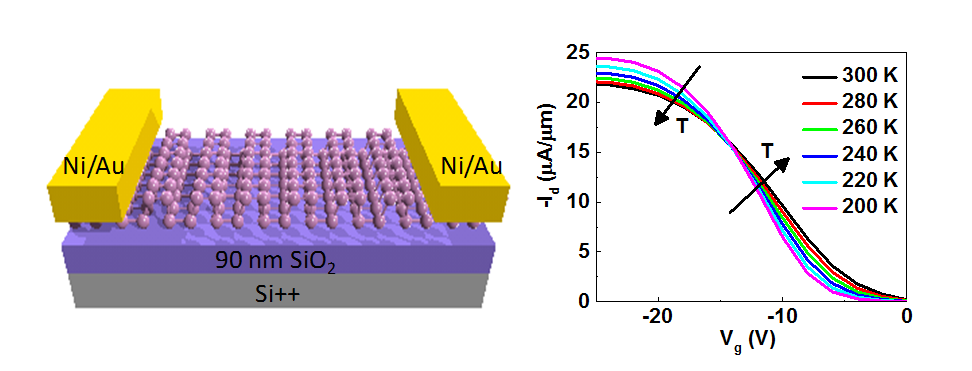
(Left) Schematic of the few-layer BP devices.
(Right) Transfer characteristics of the simulated device at various temperatures and Vd=−0.01 V.
(Nano Letters, DOI: 10.1021/acs.nanolett.7b02278)
Background
Contact resistance (Rc) between 2D materials and metal limits the performance of these devices and poses a severe challenge for the applications in electronics and optoelectronics. There is also a lack of understanding of the carrier transport mechanisms through these contacts, albeit this problem is beginning to receive more attention. The electrical characteristics of BP transistors have been shown to be dominated by the Schottky barriers (SB) which is modulated by back-gate voltage. To date, the basic physics mechanism of electrical contact between the BP channel and metal remains unclear. A new theoretical model is necessary to explain this phenomenon in 2D system. Meanwhile, the physical mechanism responsible for the metallic-insulator crossover observed for the transfer characteristics of 2D devices remains in dispute. In this work, we seek to address the issues mentioned above experimentally, in conjunction with a new theoretical model.
What we discover?
The temperature-dependent transport through the metal/BP contact has been investigated through a combination of experimental data and 2D quantum transport simulations. In particular, we have addressed two phenomena, negative SB height and crossover of the transfer characteristics, whose origin has not been completely elucidated so far. We propose that the two effects can be explained on the basis of a contact limited transport model by taking into account the electrostatic modulation of the SB by the back-gate voltage. At sufficiently high negative Vg, the SB height becomes so low that the injected carrier cannot be described anymore by the Boltzmann statistics, leading to the failure of the usual thermionic emission theory and the fact that the current can actually increase with decreasing temperature. Contrary to the common belief, the observed metallic-insulator transition in the contact is not due to the interplay between tunneling and thermionic transport, but rather that of the different carrier statistics of Fermi tail/sea electronic states.
Why is this important?
Metal-semiconductor contact has been the performance limiting problem for electronic devices and also dictates the scaling potential for future generation devices based on novel channel materials. Two-dimensional semiconductors beyond graphene, particularly few layer black phosphorus, has attracted much attention due to its exceptional electronic properties such as anisotropy and high mobility. However, due to its ultra-thin body nature, few layer black phosphorus/metal contact behaves differently than conventional Schottky barrier (SB) junctions, and the mechanisms of its carrier transport across such a barrier remains elusive. In this work, we examine the transport characteristic of metal/black phosphorus contact under varying temperature. We elucidated the origin of an apparent negative SB heights extracted from classical thermionic emission model, and also the phenomenon of metal-insulator transition observed in the current-temperature transistor characteristic.
Why did they need WHMFC?
Wuhan National High Magnetic Field Center provides great technical support during low temperature electrical measurements.
Who did the research?
Xuefei Li1, ‡,Roberto Grassi2, ‡, Sichao Li1, Tiaoyang Li1, Xiong Xiong1,Tony Low2,*and Yanqing Wu1,*
1Wuhan National High Magnetic Field Center and School of Electrical and Electronic Engineering, Huazhong University of Science and Technology, Wuhan 430074, China
2Department of Electrical and Computer Engineering, University of Minnesota, Minneapolis, Minnesota 55455, USA
